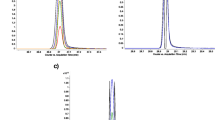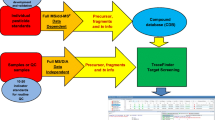Abstract
This paper describes the application of LC/Q-Orbitrap MS for the analysis of pesticide residues in fruit and vegetable commodities. LC/Q-Orbitrap MS working in full scan simultaneously with a single MS/MS scan was used to analyse 139 pesticide residues in QuEChERS extracts of tomato, pepper, orange and green tea. Full scan data were obtained at a resolution of 70,000 whereas MS/MS data were obtained at a resolution of 17,500. Quantitation and detection was carried out using full scan data while MS/MS data were used only for identification. MS/MS scans did not have a negative influence on quantitation under the applied conditions. Some peak area reproducibility problems were the consequence of the low sensitivity for some compounds (aldicarb, chlorpyriphos methyl, fenitrothion and fipronil) under the applied conditions. The relation between the operational parameters (viz. automatic gain control (AGC) target, maximum injection time (IT), underfill ratio, isolation window and apex trigger) and the number of automatically identified compounds was investigated. Mass error and minimal intensity of selected fragment ions were also studied. Various working modes were compared, such as full scan with single MS/MS scan and full scan with multiple MS/MS scans. In both cases, the number of automatically reported pesticides was the same. However full scan with single MS/MS scan ensured more points per peak in full scan mode and better peak area reproducibility. The evaluation of the identification and quantitation capabilities of the instrument was performed through the analysis of 100 real samples. The samples were also analysed by LC–QqQ MS/MS and the results of both analytical systems were compared. The comparison revealed that the two instruments were consistent with each other. They found the same pesticides and neither false positive nor false negatives were reported. Nevertheless the Q-Orbitrap MS allowed one to work in high resolution mass spectrometry, increasing the selectivity and, in full scan mode, permitting the retrospective analysis of the data feature that cannot be achieved with QqQ.




Similar content being viewed by others
References
Kaufmann A et al (2012) Study of high-resolution mass spectrometry technology as a replacement for tandem mass spectrometry in the field of quantitative pesticide residue analysis. J AOAC Int 95(2):528–548
Alder L, Steinborn A, Bergelt S (2011) Suitability of an Orbitrap mass spectrometer for the screening of pesticide residues in extracts of fruits and vegetables. J AOAC Int 94(6):1661–1673
Kellmann M et al (2009) Full scan MS in comprehensive qualitative and quantitative residue analysis in food and feed matrices: how much resolving power is required? J Am Soc Mass Spectrom 20(8):1464–1476
Mol HG, Zomer P, de Koning M (2012) Qualitative aspects and validation of a screening method for pesticides in vegetables and fruits based on liquid chromatography coupled to full scan high resolution (Orbitrap) mass spectrometry. Anal Bioanal Chem 403(10):2891–2908
Kaufmann A et al (2011) Development of an improved high resolution mass spectrometry based multi-residue method for veterinary drugs in various food matrices. Anal Chim Acta 700(1–2):86–94
Ates E et al (2014) Screening of plant and fungal metabolites in wheat, maize and animal feed using automated on-line clean-up coupled to high resolution mass spectrometry. Food Chem 142:276–284
Mol HG et al (2011) Screening of plant toxins in food, feed and botanicals using full-scan high-resolution (Orbitrap) mass spectrometry. Food Addit Contam Part A Chem Anal Control Expo Risk Assess 28(10):1405–1423
Farre M, Pico Y, Barcelo D (2013) Direct peel monitoring of xenobiotics in fruit by direct analysis in real time coupled to a linear quadrupole ion trap-orbitrap mass spectrometer. Anal Chem 85(5):2638–2644
Jia W et al (2014) Multi-mycotoxin analysis in dairy products by liquid chromatography coupled to quadrupole orbitrap mass spectrometry. J Chromatogr A 1345:107–114
Vaclavik L et al (2013) Determination of multiple mycotoxins in dietary supplements containing green coffee bean extracts using ultrahigh-performance liquid chromatography-tandem mass spectrometry (UHPLC-MS/MS). J Agric Food Chem 61(20):4822–4830
Fedorova G et al (2013) Comparison of the quantitative performance of a Q-Exactive high-resolution mass spectrometer with that of a triple quadrupole tandem mass spectrometer for the analysis of illicit drugs in wastewater. Rapid Commun Mass Spectrom 27(15):1751–1762
Shi F et al (2014) Application of a high resolution benchtop quadrupole-Orbitrap mass spectrometry for the rapid screening, confirmation and quantification of illegal adulterated phosphodiesterase-5 inhibitors in herbal medicines and dietary supplements. J Chromatogr A 1344:91–98
Kumar P et al (2013) Targeted analysis with benchtop quadrupole-orbitrap hybrid mass spectrometer: application to determination of synthetic hormones in animal urine. Anal Chim Acta 780:65–73
Wang J et al (2012) Application of ultrahigh-performance liquid chromatography and electrospray ionization quadrupole orbitrap high-resolution mass spectrometry for determination of 166 pesticides in fruits and vegetables. J Agric Food Chem 60(49):12088–12104
Jia W et al (2014) High-throughput screening of pesticide and veterinary drug residues in baby food by liquid chromatography coupled to quadrupole Orbitrap mass spectrometry. J Chromatogr A 1347:122–128
Malato O et al (2011) Benefits and pitfalls of the application of screening methods for the analysis of pesticide residues in fruits and vegetables. J Chromatogr A 1218(42):7615–7626
Lozano A et al (2014) Evaluation of zirconium dioxide-based sorbents to decrease the matrix effect in avocado and almond multiresidue pesticide analysis followed by gas chromatography tandem mass spectrometry. Talanta 118:68–83
Rajski Ł, Gomez-Ramos MM, Fernandez-Alba AR (2014) Large pesticide multiresidue screening method by liquid chromatography-Orbitrap mass spectrometry in full scan mode applied to fruit and vegetables. J Chromatogr A 1360:119–127
European Commission, Health & Consumer Protection Directorate-General (2013) Guidance document on analytical quality control and validation procedures for pesticide residues analysis in food and feed, SANCO/12571/2013. EC, Brussels
Acknowledgments
The authors acknowledge funding support from The European Commission, DG SANCO (Specific Agreement No. 2007/1 to Framework Partnership Agreement No. SANCO/2007/FOOD SAFETY/025-Pesticides in Fruit and vegetables). The authors also would like to thank Michal Godula from Thermo Fisher Scientific for providing LC/Q-Orbitrap MS and constant support of the work.
Author information
Authors and Affiliations
Corresponding author
Additional information
Published in the topical collection High-Resolution Mass Spectrometry in Food and Environmental Analysis with guest editor Aldo Laganà.
Electronic supplementary material
Below is the link to the electronic supplementary material.
ESM 1
(PDF 176 kb)
Rights and permissions
About this article
Cite this article
del Mar Gómez-Ramos, M., Rajski, Ł., Heinzen, H. et al. Liquid chromatography Orbitrap mass spectrometry with simultaneous full scan and tandem MS/MS for highly selective pesticide residue analysis. Anal Bioanal Chem 407, 6317–6326 (2015). https://doi.org/10.1007/s00216-015-8709-z
Received:
Revised:
Accepted:
Published:
Issue Date:
DOI: https://doi.org/10.1007/s00216-015-8709-z




